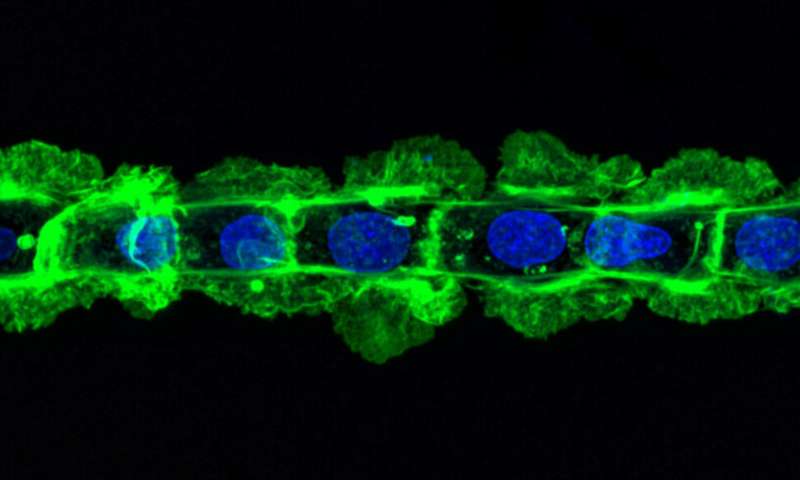How do epithelial cell trains migrate in confined environments ?

An article published by Professor Sylvain Gabriele's team of the University of Mons (Belgium) in the upcoming issue of the scientific journal Nature Physics identifies for the first time the physico-chemical mechanisms involved in the migration of small groups of epithelial cells in confined environments. These mechanisms, which play a crucial role in the coordinated migration of tumor cells, could potentially become therapeutic targets to block the dissemination of metastatic cells.
Epithelial cells cover the surface of most of our organs, forming a layer of cells capable of moving to form organs or heal wounds. In patients with tumors derived from epithelial cells (or carcinomas), 90% of deaths are caused by secondary tumors called metastases. These metastases begin when cells leave the primary tumor and migrate into neighboring tissues, passing through spaces smaller than their size to reach other organs. Although tissues present restricted spaces, increasing evidence indicates that these cells do not move individually but in small groups of a few cells, a phenomenon known as collective migration. However, the mechanisms enabling these colonies of cells to migrate efficiently in confined environments remain poorly understood.
In this article, the team of researchers from UMONS successfully formed small colonies of epithelial cells and replicated their migration in confined spaces. To achieve this, they modified the biochemistry of the culture surfaces by depositing micrometric strips of adhesive proteins to guide the migration of these colonies. By adjusting the width of these strips, the researchers controlled the size of the colonies, forming either aligned trains of cells or wider colonies. Professor Sylvain Gabriele's team observed, through fluorescence microscopy, the movement of these cell groups on the tracks and showed that the length of the cell trains did not change their speed, but the wider the trains, the slower they moved. This discovery demonstrates that it is more efficient to form an aligned train of cells to move a small group of cells in a confined environment than to form a larger colony. Interestingly, the movement speed of these cell trains does not depend on the number of cells, suggesting that the dissemination of cell groups of different sizes occurs at the same speed in human tissues.
To better understand why larger colonies were slower, the first author of this article, Eléonore Vercruysse (FRIA-FNRS graduate student), spent several months in the team of Prof. Xavier Trepat (IBEC, Spain). The results indicate that epithelial cells in larger colonies form significant lateral adhesive contacts, and the energy used to maintain these contacts comes at the expense of the energy available to move the group of cells forward. The researchers from UMONS then collaborated with Prof. Edouard Hannezo and Dr. David Brückner (IST, Austria) to explain, using simple physical principles, how the establishment of lateral adhesive contacts between neighboring cells reduces the migration speed of cell clusters.
Given that the deregulation of adhesive contacts in epithelial cells is a key step in tumor transition, these results provide a better understanding of the mechanisms of cancer cell migration. Notable advancements are expected from studying the migration of trains of tumor cells derived from human biopsies, using the innovative adhesive microsystems developed in this project. The potential impact of this work could pave the way for revolutionary therapeutic approaches and offer a better understanding of the mechanisms of tumor dissemination.
More information:
Geometry-driven migration efficiency of autonomous epithelial cell clusters
Eléonore Vercruysse, David B. Brückner, Manuel Gómez-González, Alexandre Remson, Marine Luciano, Yohalie Kalukula, Leone Rossetti, Xavier Trepat, Edouard Hannezo & Sylvain Gabriele*
Nature Physics (2024)
DOI : 10.1038/s41567-024-02532-x
Readcube: rdcu.be/dLgVz
Provided by University of Mons